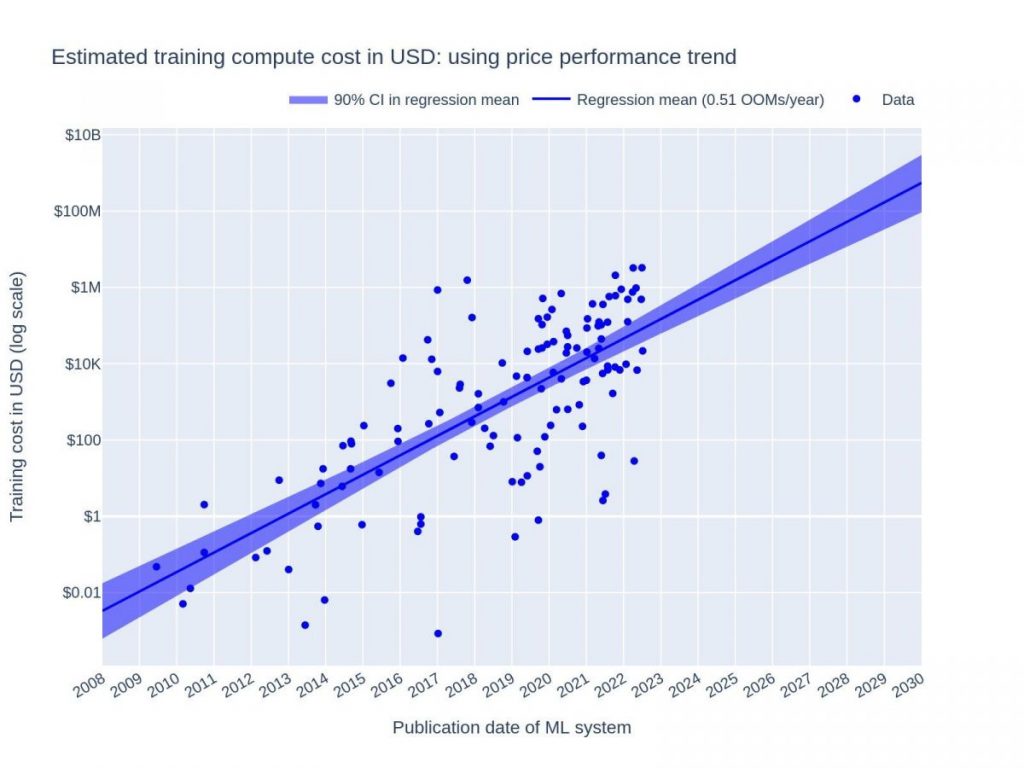AI Model Training Costs Are Expected to Rise from $100 Million to $500 Million by 2030

In Brief
According to a recent OpenAI report, the cost of training large AI models will rise from $100 million to $500 million by 2030.
The need for more data is one of the main factors driving up the cost of training machine learning models.
AI investments are heavily influenced by the cost of training machine learning models.
A recent report by OpenAI has found that the cost of training large AI models is expected to rise from $100 million to $500 million by 2030. This is a staggering increase, and it means that only the wealthiest companies and individuals will be able to afford to develop and use AI technologies.

The report found that the cost of training a single large AI model can range from $3 million to $12 million. The cost of training a model on a large dataset can be even higher, reaching up to $30 million.
OpenAI estimates that the cost of training a model on a large dataset will increase to $500 million by 2030. This is due to the increasing size of datasets, as well as the need for more computing power to train larger models.
Currently, most AI research is being conducted by large tech companies and organizations, such as Google, Facebook, and Microsoft. However, with the rising cost of AI model training, only the wealthiest companies and individuals will likely be able to afford to develop and use AI technologies in the future.
This could have a number of implications for the future development of AI. Firstly, it could lead to a concentration of AI development in the hands of a few large companies. Secondly, it could create a divide between those who can afford to use AI technologies and those who cannot.
The rising cost of AI development could also have negative implications for society as a whole. For instance, it could lead to the development of AI technologies that only benefit the wealthy, and it could exacerbate inequality. This can put society at risk.
It is important to note that the cost of AI development is not the only factor determining who can afford to use AI technologies.
In whose hands will AI be in five years?
The cost of training machine learning models has been steadily rising. The report, titled “Trends in the Dollar Cost of Training Machine Learning Systems,” was published by researchers at OpenAI, an artificial intelligence research lab. It analyzed the cost of training various machine learning models over the past five years and found that the cost has been increasing at an exponential rate.

One of the main factors driving up the cost of training machine learning models is the need for more data. As models become more complex, they require more data in order to learn accurately. This has led to a “data race” as companies compete to collect and label ever-larger datasets.
The other major factor driving the cost of training machine learning models is the need for more computing power. Training a model requires massive amounts of processing power, and the amount of power required has been increasing exponentially.
The report predicts that the cost of training a single machine-learning model will reach $500 million by 2030. This is a significant increase from the current cost of $100 million. However, the report also notes that advances in GPUs could reduce the cost somewhat, bringing the cost down to $200 million by early 2030.
This trend has major implications for the AI industry. Investments in AI depend heavily on the cost of training machine learning models. If the cost of training continues to rise at its current rate, it will become increasingly difficult for companies to justify investing in AI.
AI investments are reliant on this price depending on the ratio of expenses for the development and training of AI to income from AI systems. Who, then, can afford the training expenses indicated above? The vector of AI growth then becomes evident in its orientation.
Read more about AI:
Disclaimer
In line with the Trust Project guidelines, please note that the information provided on this page is not intended to be and should not be interpreted as legal, tax, investment, financial, or any other form of advice. It is important to only invest what you can afford to lose and to seek independent financial advice if you have any doubts. For further information, we suggest referring to the terms and conditions as well as the help and support pages provided by the issuer or advertiser. MetaversePost is committed to accurate, unbiased reporting, but market conditions are subject to change without notice.
About The Author
Damir is the team leader, product manager, and editor at Metaverse Post, covering topics such as AI/ML, AGI, LLMs, Metaverse, and Web3-related fields. His articles attract a massive audience of over a million users every month. He appears to be an expert with 10 years of experience in SEO and digital marketing. Damir has been mentioned in Mashable, Wired, Cointelegraph, The New Yorker, Inside.com, Entrepreneur, BeInCrypto, and other publications. He travels between the UAE, Turkey, Russia, and the CIS as a digital nomad. Damir earned a bachelor's degree in physics, which he believes has given him the critical thinking skills needed to be successful in the ever-changing landscape of the internet.
More articles

Damir is the team leader, product manager, and editor at Metaverse Post, covering topics such as AI/ML, AGI, LLMs, Metaverse, and Web3-related fields. His articles attract a massive audience of over a million users every month. He appears to be an expert with 10 years of experience in SEO and digital marketing. Damir has been mentioned in Mashable, Wired, Cointelegraph, The New Yorker, Inside.com, Entrepreneur, BeInCrypto, and other publications. He travels between the UAE, Turkey, Russia, and the CIS as a digital nomad. Damir earned a bachelor's degree in physics, which he believes has given him the critical thinking skills needed to be successful in the ever-changing landscape of the internet.






















































